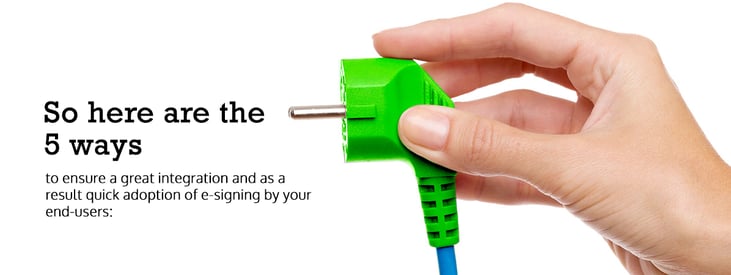In this blog, we discuss our top five ways to accelerate eSignature adoption in your business.
Implementing an eSignature solution successfully can be a great investment, quickly saving enormous time and money for your organisation, whilst easing life for your customers, employees and partners. But how do you get it right and not be left with yet another system for users to learn and/or avoid?
From our experience, it’s all in the integration. That is, how seamless is the user experience from interacting with your business applications to interacting with the e-signing platform in getting documents prepared, sent, signed and completed.
In SigningHub, we have focussed heavily on the user experience. We actually refer to the term “tight integration” when all of the e-signing functionality is so tightly-embedded inside the business application that users aren’t even aware that we are involved. It's often the case, the more you hide technology the more it will be actually used and accepted!

5 tips for accelerating eSignature adoption
1. Automatically register users
No user likes to fill in registration forms! Your business application should be able to register users automatically using the e-signing API.
2. Implement Single Sign On (SSO)
Similarly no user likes to preform unnecessary logins. If a user has just logged into your business application why should they have to login again to the e-signing platform?
The eSignature platform should be able to automatically re-use any existing authentications (OAuth, SAML etc.) as long as not expired. Standard identity federation techniques should be used.
3. Avoid browser redirects
A seamless user experience requires the user to feel they are only interacting with one application, so there should be no browser redirects, no new and weird/unrecognised URLs in the browser address bar, no new colours/branding of web page design.
We recommend an iFrame inside your business application web page which simply displays the document and allows the user’s e-signature with crypto digital signature to be captured.
4. Avoid signing complexity
Users want to just review and sign a document as quickly as possible and move on. They don’t want to hunt for things or be bombarded with features and settings.
Normally from a user’s perspective all that is needed are two simple “sign” and “decline” buttons. For legal reasons a “legal notice” may need to be shown to prove they understood the implications of their signing actions.
In case of signing a large number of documents there should be a bulk signing feature which automates the process of opening, viewing and signing each document individually. The system should automatically step-in if the user is making a mistake, e.g. about to sign an incomplete form or forgetting to initial somewhere in the document.
5. Sign from any device, anywhere, anytime
The world is increasingly digital and people are no longer tied to their desk or office. You should be able to access your documents from any device, all automatically synched.
Signing should be secure to required legal levels demanded by your business requirements. Typically this means your signing key is held centrally in a secure tamper-resistant hardware module (HSM), and accessible from anywhere after your successful authentication.
SigningHub helps streamline eSignature adoption
If you get the integration right, you will have everyone thanking you for much easier life is with eSignatures compared to printing and distributing paper documents.
There are a lot of lower-level, subtle things to think about from an end-user's perspective to get things just right. Contact us if you need help fine-tuning your thoughts on how to integrate eSignatures into your business applications.


